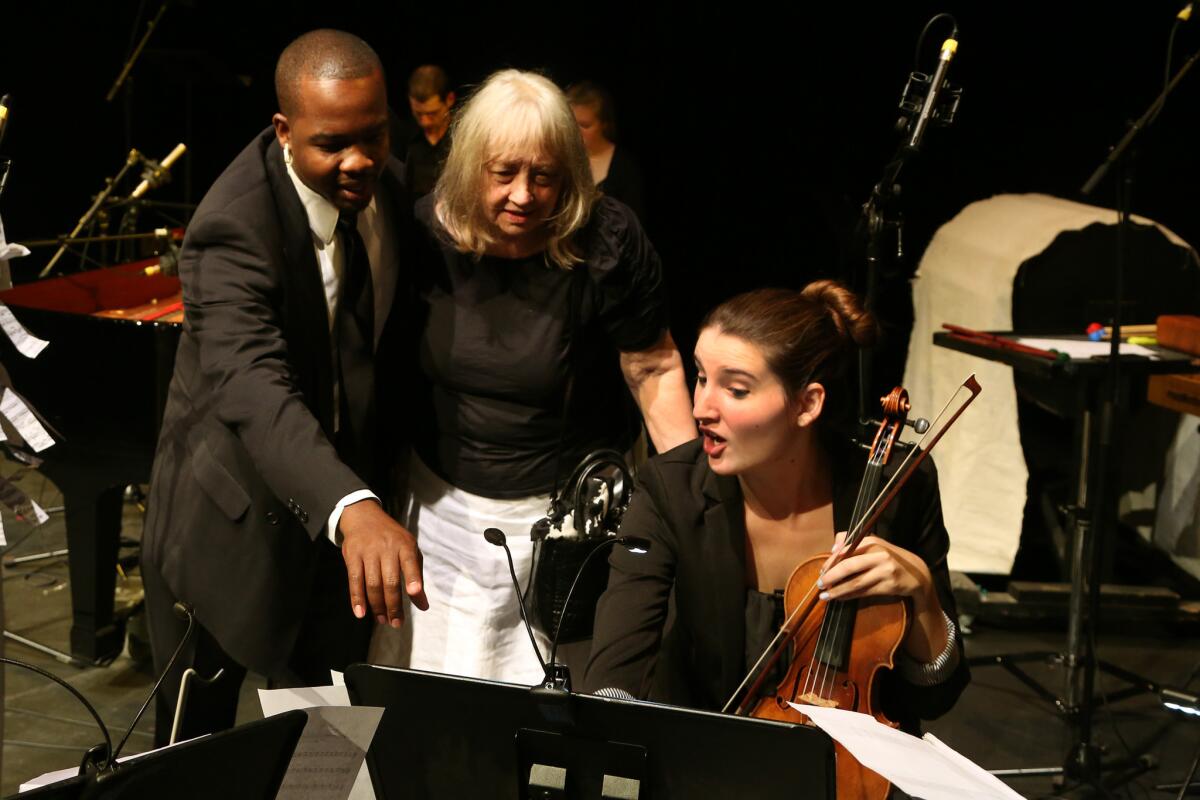Review: Gloria Coates’ great oddity on display at REDCAT

- Share via
A mesmerizing American symphonist, Gloria Coates is our last maverick.
The music establishment has gotten reasonably adept at sweeping up composers — men and women of all backgrounds, races and ages — who break bounds. There are few if any barriers anymore for a composer of talent.
But Coates, who has written 16 symphonies, far more than any of today’s important American composers and nine string quartets, also a record for a major contemporary American composer, is barely known at all in this country.
Born in Wisconsin in 1938, she made her first visit to Los Angeles on Thursday night for the U.S. premiere of her Tenth Symphony and the first performance, though in a workshop version, of her only opera, “Stolen Identity,” at REDCAT.
Of the handful of CDs of her music, all but one are on foreign labels and it is hard to spot an American performer anywhere. Rather, one sees names such as Orchester des Internationalen Jugendfestspieltreffens Bayreuth, conducted by Matthias Kuntzsch. The string quartet devoted to her music is the Kreutzer, a British ensemble. Only a couple of her early symphonies from 1970s have had performances in the U.S.
One vaguely plausible reason for this is that she has lived in Munich since 1969. One slightly more plausible explanation is that she is an outsider, not a participant of the international music promotion business. One implausible reason is because her symphonies and string quartets are so weird.
Coates is a master of microtones, of taking a listener to aural places you never knew could exist and finding the mystical spaces between tones. Her genius is to connect these far-off musical milieus with our world and our vital concerns, with myth, with the environment, with war and peace.
Those connections, musically and spiritually, are so strong that Coates’ brief appearance at REDCAT became a kind of Music Center glue tying together some of the most meaningful musical activities that have been going on with the musical institutions on campus this fall. Coates’ Fourth Symphony, for instance, refashions Dido’s Lament from Purcell’s “Dido and Aeneas” into uncanny glissandi and strange harmonies in which lamentation becomes a ritual of memory as an act of distortion. It could be heard as the missing entr’acte connecting the distant worlds between the current Los Angeles Opera double bill of Purcell’s opera and Bartók’s “Bluebeard’s Castle.”
Coates’ Tenth Symphony, written in 1992 for a large ensemble of keening brass and pulsating percussion, heralded the evocative percussion pieces by David Lang and Michael Gordon with which the L.A. Phil opened its season. Her opera offers a new perspective on Emily Dickinson, using some of the same texts as John Adams’ “Harmonium,” sung by the Los Angeles Master Chorale this fall.
Titled “Drones of Druids on Celtic Ruins,” that Tenth Symphony begins with the whoosh of a wind machine, the thump of a bass drum and yowling trumpets and horns, which also connects with the L.A. Phil’s performance of Varèse’s “Amériques” last week. In the second of the three movements, snare drum rolls take over a listener’s senses, magnificently magnifying Varèse’s early percussion experiments. Coates’ marvelous invention in the third movement is to so tire the brass players lips that their intonation begins to falter, revealing her quest for new tunings as a natural process.
However strange and otherworldly, the symphony is music of purpose, as much of Coates’ music is. She wrote it to be played outdoors at Celtic archaeological sites in Germany threatened by proposed highway construction in 1995. So far it has worked; the highway has been postponed indefinitely.
Coates’ opera is a kind of summing up. She intersperses movements from her fifth, eighth and ninth string quartets with songs she has written over the last 50 years, mostly to Dickinson texts and inventively accompanied by piano, percussion and string quartet. To this she has created an allegorical narrative of a musical bird stabbed with violin bows by a thief meant to represent the modern drives of “speed, greed and media.” The thief steals the bird’s song, but an angel intervenes.
The songs and the eerily ethereal string quartet music are sensational, as is Coates’ Tenth Symphony. CalArts found fine performers for both. The opera featured the Isaura String Quartet newly formed by CalArts graduates, tenor Timur Bekbosunov, baritone Babatunde Akinboboye and soprano Carmina Escobar.
But the symphony is outdoor music, which proved claustrophobic in the confined REDCAT space and was conducted with a distractingly plodding beat by Susan Allen. Allen, however, was a much more effective harpist in Coates’ resourcefully resonating “Night Music,” abetted by saxophonist Ulrich Krieger and percussionist Joshua Carro.
The opera got a literal, mannered staging by the first violinist of the Isaura, Madeline Falcone, which made the 90-minute production a chore. The score needs, instead, a visual atmosphere and nothing more.
Coates’ spoken text is also an obstacle. I’d suggest stealing some of the identity of “Stolen Identity,” which obscures what is essentially one of the most effective song cycles by the woman who may well be the most obscure great composer of our time.
Twitter: @markswed
More to Read
The biggest entertainment stories
Get our big stories about Hollywood, film, television, music, arts, culture and more right in your inbox as soon as they publish.
You may occasionally receive promotional content from the Los Angeles Times.











